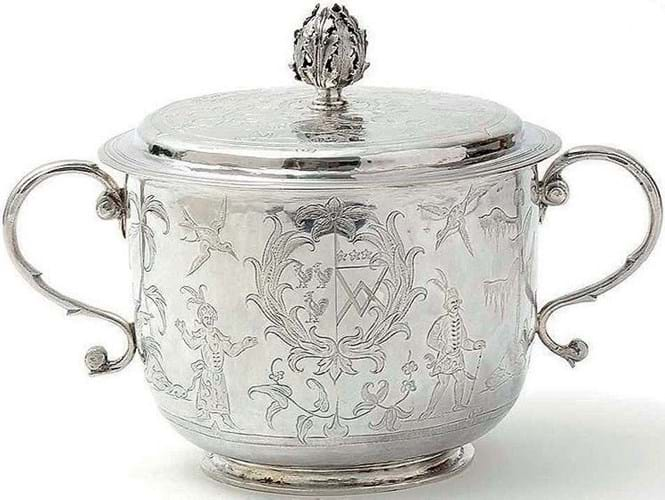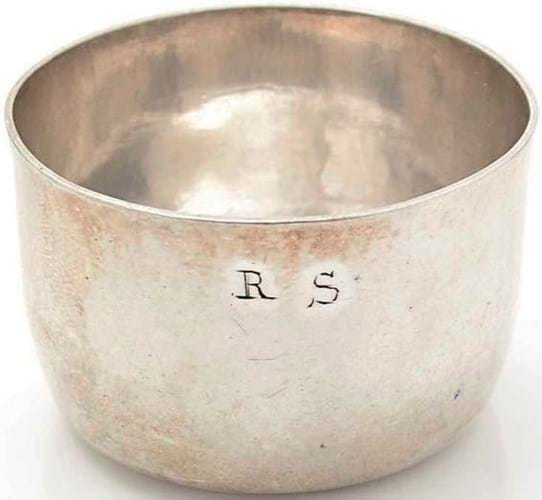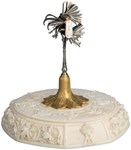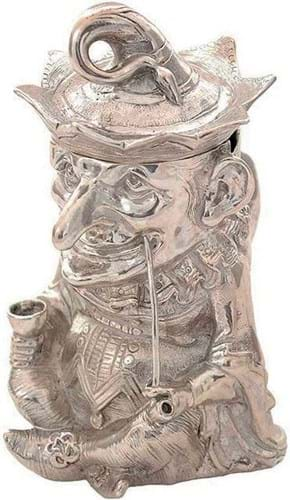
A single-owner collection of mustard pots offered by Anderson & Garland was led by this example from 1869 modelled as Mr Punch which made £3100 at Anderson & Garland.
A selection of mustard pots offered in Newcastle was thought to be the largest dispersal to appear at auction since the Colman collection was sold around 30 years ago by Christie’s.
That was the view of Anderson & Garland (25% buyer’s premium) specialist Alex Butcher, relating to group of about 100 lots featuring in the November 28 dedicated silver sale.
Formed by a local collector over the past 35 years, it comprised a large proportion of the around 500 lots of silverware at an auction in which smallwork and collectors’ pieces featured heavily.
A further sizeable slice was provided by the second instalment of a collection of caddy spoons which accounted for around 100 lots.
Animal magic
The mustard pots – some of which were previewed in an article in ATG No 2619 – provided a sizeable number of the highest prices, including four of the top 10 lots.
Many of these best-sellers took the form of novelty designs fashioned as animals or miniature models of objects.
The highest-priced example was a 4in (10cm) high 6.6oz version by London silversmith Robert Hennell cast as a seated figure of Mr Punch, a popular model used by many Victorian silversmiths (another version by Charles Stuart Harris realised £3600 at Woolley & Wallis on October 31).
Pictured top, the character was shown seated cross legged and smoking a long stemmed pipe, the lid of the condiment formed as upturned calyx or flowerhead with the stem curled round to form a handle. Hallmarked for 1869 and with a registered design lozenge, it sold for £3100 (estimate £700-900).
Interesting boar
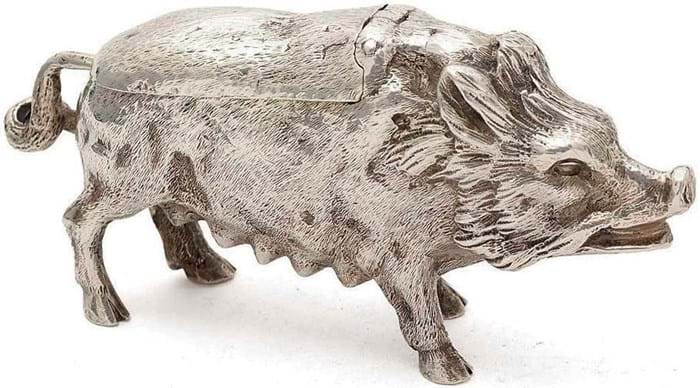
Many of the novelty mustard pots in the collection were modelled as animals like this version from 1880 formed as a wild boar sow, £2600 at Anderson & Garland.
Among the animal models, a 4.25oz cast pot formed as a wild boar sow chased with a rough coat and with the curly tail doubling up as a spoon, by Joseph Braham, London 1880, realised £2600 and another design by Robert Hennell from 1876 cast as a cat seated on its haunches with a hinged head, 3.5oz, made £1900.
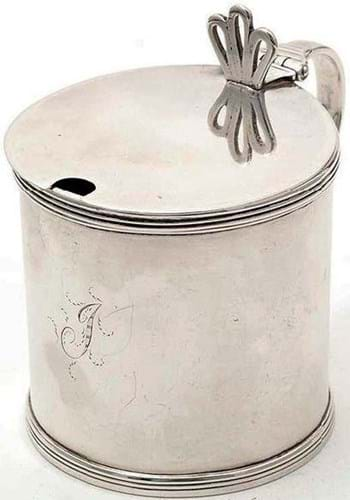
Plain drum-shaped provincial silver mustard pot with York marks for 1796 sold for £3000 at Anderson & Garland.
Not all the top-priced mustard pots were novelty versions. The attraction of a rare piece of provincial silver in the form of a plain drum-shaped pot, 3in (7.5cm) high, was that it was struck with the often elusive York town mark, something which propelled it to £3000, a multiple of the £250-300 guide. It was marked for Messrs Hampston and Prince of York, 1796.
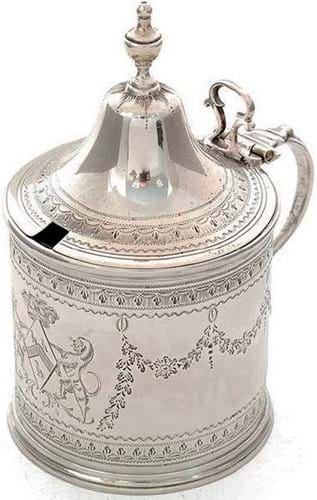
Mustard pot of neoclassical design marked for Hester Bateman 1786, sold for £1700 at Anderson & Garland.
And a good example of neo-classical silver, from 1786, a 4in (10.7cm) high bright-engraved pot with an urn finial and the arms of a baroness to the front, realised £1700 against a £300-400 guide.
This was by Hester Bateman, a silversmith whose work has long had a strong collectors’ following whatever the form.
The earliest mustard pot in the sale was a Britannia standard model of caster form by Anthony Nelme from 1722 made to contain dry powered mustard rather than the wet form. It sold for £480.
Novelty served up
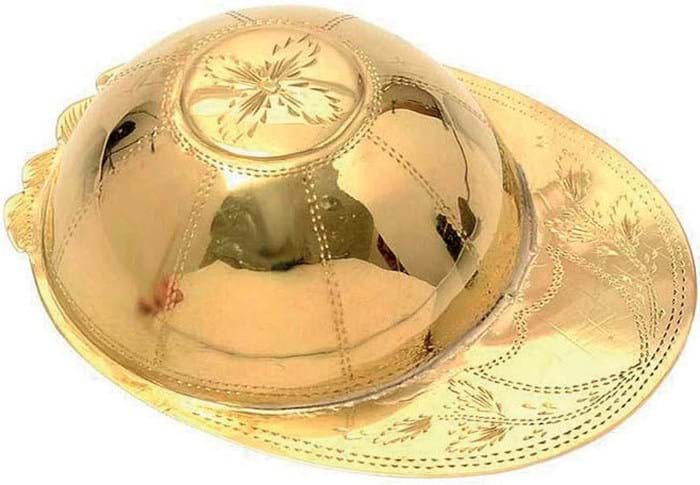
The most expensive caddy spoon in the auction was this gold example from c.1800 shaped as a jockey’s cap, £1050 at Anderson & Garland.
As with mustard pots, novelty is a strong appealing factor with caddy spoons.
Best-seller in this auction was a gold version weighing .25oz in a popular design: fashioned as a jockey’s cap with the peak forming the handle.
This was unmarked but was probably the work of Joseph Taylor of Birmingham, c.1800, and was formerly in the collection of John Norie whose caddy spoon collection was sold by Woolley & Wallis in 2004. It sold here for £1050.
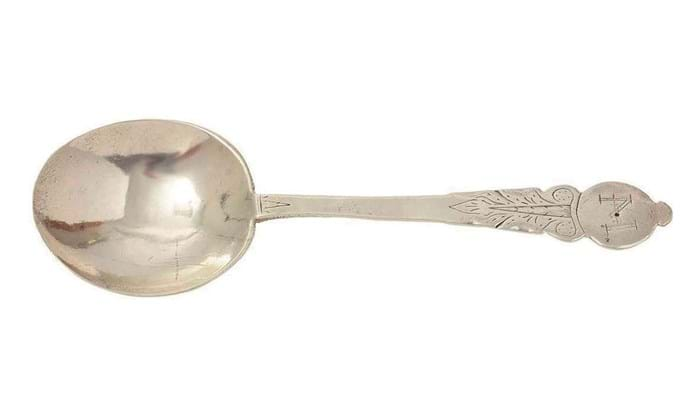
The mid-17th century Scottish disc-end spoon that led the silver sale at Anderson & Garland at £10,800.
The auction also included some early spoons, another longstanding collecting category, and it was one of these that provided the day’s top price overall.
This was a rare Scottish example: a 7in (17.5cm) long spoon of so-called disc-end type, a form unique to Scotland that was in production for about a century from the late 1580s.
Anderson & Garland’s example dated from the mid 17th century, having an Edinburgh Deacon’s mark for George Cleghorne dating it to 1648-50 with a maker’s mark for either John Mylne or James McAulay.
Like many early spoons, it was also scratch engraved with the monogram of its owner – the initials to the terminal reading either HM or MH.
Some substantial sums have been bid in recent years for these rare disc-end spoons, including the £22,000 at Lyon & Turnbull in 2012 for a c.1650 spoon marked for Peter Neilson or the earlier c.1619-21 example by Gilbert Kirkwood which realised £21,000 in the same rooms in 2020.
Anderson & Garland’s example, which was guided at £12,000-15,000, came in at a lower £10,800.
Exotic decoration
Turning to the hollowwares, the catalogue featured a very attractive example of Carolean chinoiserie-decorated silver, a Charles II period campana shaped 7in (18cm) high covered porringer with typical S-scroll form handles and a bud-shaped finial guided at £10,000-15,000.
The chinoiserie chased decoration featured motifs that were characteristic of this style: exotic birds and figures plus foliage, as well as a dragon water fountain.
It was also engraved with an armorial, possibly for Cockayne. Marked for London 1683, the maker was probably Nathaniel Weekly.
In form and decoration this porringer was not dissimilar to a covered example from the same year with the same bud finial by the well-known London goldsmith Benjamin Pyne offered by Woolley & Walllis in 2021, that was also estimated at £10,000-15,000 but went for £26,000.
The example in Newcastle, however, went for rather less, selling just under the guide at £9000.
Making rather more than its £600-800 guide here, at £1700, was another more modest piece of Charles I period silver: a small plain tumbler cup of c.1670, just 2½in (5cm) in diameter, engraved with the initials RS and AR.
It had a maker’s mark only of IT in a shaped shield probably for John Thompson (or Thomason), but significantly this was a York goldsmith, making it more attractive as a piece of provincial silver.


